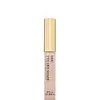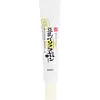What's inside
What's inside
 Key Ingredients
Key Ingredients

 Benefits
Benefits

 Concerns
Concerns

No concerns
 Ingredients Side-by-side
Ingredients Side-by-side

Water
Skin ConditioningPlacental Protein
HumectantButylene Glycol
HumectantYeast Extract
Skin ConditioningRoyal Jelly Extract
Skin ConditioningBiosaccharide Gum-1
HumectantPentylene Glycol
Skin ConditioningStyrene/Vp Copolymer
Dipotassium Glycyrrhizate
HumectantCarbomer
Emulsion StabilisingPhenoxyethanol
PreservativeAminomethyl Propanol
BufferingMagnesium Aluminum Silicate
AbsorbentCaffeine
Skin ConditioningXanthan Gum
EmulsifyingRutin
AntioxidantAcetyl Tyrosine
Skin ConditioningPaeonia Suffruticosa Root Extract
Skin ProtectingPueraria Lobata Root Extract
HumectantWater, Placental Protein, Butylene Glycol, Yeast Extract, Royal Jelly Extract, Biosaccharide Gum-1, Pentylene Glycol, Styrene/Vp Copolymer, Dipotassium Glycyrrhizate, Carbomer, Phenoxyethanol, Aminomethyl Propanol, Magnesium Aluminum Silicate, Caffeine, Xanthan Gum, Rutin, Acetyl Tyrosine, Paeonia Suffruticosa Root Extract, Pueraria Lobata Root Extract
Water
Skin ConditioningGlycerin
HumectantButylene Glycol
HumectantSqualane
EmollientDipentaerythrityl Tetrahydroxystearate/Tetraisostearate
Skin ConditioningBehenyl Alcohol
EmollientPvp
Emulsion StabilisingPentaerythrityl Tetraethylhexanoate
EmollientPEG-150
HumectantDimethicone
EmollientPentylene Glycol
Skin ConditioningBeeswax
Emulsion StabilisingDipentaerythrityl Tri-Polyhydroxystearate
EmollientPEG-60 Glyceryl Isostearate
Macadamia Ternifolia Seed Oil
EmollientGlyceryl Stearate
EmollientTrimethylsiloxysilicate
EmollientRetinol
Skin ConditioningRetinyl Palmitate
Skin ConditioningMilk Ferment
Skin ConditioningSoy Isoflavones
Skin ConditioningGlycine Max Seed Extract
Skin ConditioningCeramide Ng
Skin ConditioningSodium Tocopheryl Phosphate
AntioxidantDipropylene Glycol
HumectantPEG-40 Hydrogenated Castor Oil
EmulsifyingPPG-4-Ceteth-20
EmulsifyingSodium Ascorbate
AntioxidantAlcohol Denat.
AntimicrobialEthylhexylglycerin
Skin ConditioningCarbomer
Emulsion StabilisingXanthan Gum
EmulsifyingZea Mays Oil
EmulsifyingTocopherol
AntioxidantCaprylic/Capric Triglyceride
MaskingPolysorbate 80
EmulsifyingInulin Lauryl Carbamate
Emulsion StabilisingLecithin
EmollientSodium Hydroxide
BufferingPhenoxyethanol
PreservativeMethylparaben
PreservativeWater, Glycerin, Butylene Glycol, Squalane, Dipentaerythrityl Tetrahydroxystearate/Tetraisostearate, Behenyl Alcohol, Pvp, Pentaerythrityl Tetraethylhexanoate, PEG-150, Dimethicone, Pentylene Glycol, Beeswax, Dipentaerythrityl Tri-Polyhydroxystearate, PEG-60 Glyceryl Isostearate, Macadamia Ternifolia Seed Oil, Glyceryl Stearate, Trimethylsiloxysilicate, Retinol, Retinyl Palmitate, Milk Ferment, Soy Isoflavones, Glycine Max Seed Extract, Ceramide Ng, Sodium Tocopheryl Phosphate, Dipropylene Glycol, PEG-40 Hydrogenated Castor Oil, PPG-4-Ceteth-20, Sodium Ascorbate, Alcohol Denat., Ethylhexylglycerin, Carbomer, Xanthan Gum, Zea Mays Oil, Tocopherol, Caprylic/Capric Triglyceride, Polysorbate 80, Inulin Lauryl Carbamate, Lecithin, Sodium Hydroxide, Phenoxyethanol, Methylparaben
 Reviews
Reviews

Ingredients Explained
These ingredients are found in both products.
Ingredients higher up in an ingredient list are typically present in a larger amount.
Butylene Glycol (or BG) is used within cosmetic products for a few different reasons:
Overall, Butylene Glycol is a safe and well-rounded ingredient that works well with other ingredients.
Though this ingredient works well with most skin types, some people with sensitive skin may experience a reaction such as allergic rashes, closed comedones, or itchiness.
Learn more about Butylene GlycolCarbomer is a polymer of acrylic acid. Its main role is to create a gel consistency.
A high amount of carbomer can cause pilling or balling up of products. Don't worry, most products contain 1% or less of carbomer.
Pentylene glycol is typically used within a product to thicken it. It also adds a smooth, soft, and moisturizing feel to the product. It is naturally found in plants such as sugar beets.
The hydrophilic trait of Pentylene Glycol makes it a humectant. As a humectant, Pentylene Glycol helps draw moisture from the air to your skin. This can help keep your skin hydrated.
This property also makes Pentylene Glycol a great texture enhancer. It can also help thicken or stabilize a product.
Pentylene Glycol also acts as a mild preservative and helps to keep a product microbe-free.
Some people may experience mild eye and skin irritation from Pentylene Glycol. We always recommend speaking with a professional about using this ingredient in your routine.
Pentylene Glycol has a low molecular weight and is part of the 1,2-glycol family.
Learn more about Pentylene GlycolPhenoxyethanol is a preservative that has germicide, antimicrobial, and aromatic properties. Studies show that phenoxyethanol can prevent microbial growth. By itself, it has a scent that is similar to that of a rose.
It's often used in formulations along with Caprylyl Glycol to preserve the shelf life of products.
Water. It's the most common cosmetic ingredient of all. You'll usually see it at the top of ingredient lists, meaning that it makes up the largest part of the product.
So why is it so popular? Water most often acts as a solvent - this means that it helps dissolve other ingredients into the formulation.
You'll also recognize water as that liquid we all need to stay alive. If you see this, drink a glass of water. Stay hydrated!
Learn more about WaterXanthan gum is used as a stabilizer and thickener within cosmetic products. It helps give products a sticky, thick feeling - preventing them from being too runny.
On the technical side of things, xanthan gum is a polysaccharide - a combination consisting of multiple sugar molecules bonded together.
Xanthan gum is a pretty common and great ingredient. It is a natural, non-toxic, non-irritating ingredient that is also commonly used in food products.
Learn more about Xanthan Gum